Tribe Irideae Rank Species | Subfamily Iridoideae Higher classification Irises | |
Similar Irises, Iris variegata, Iris aphylla, Iris spuria, Iridaceae | ||
Iris graminea, is a species in the genus Iris belonging to the subgenus Limniris, in particular the series Spuriae. It is a rhizomatous perennial, with purple or violet blue flowers almost hidden by narrow, grass-like leaves, and a plum scented fragrance. It is cultivated as an ornamental plant in temperate regions. It has several common names, including Grass-Leaved Flag, Grass leaved Iris, Plum Iris and Plum tart Iris (because of the scent). This species naturally occurs in the southern half of Europe, from Spain and France in the West to Russia and the Caucasus in the East.
Contents
- Description
- Biochemistry
- Taxonomy
- Distribution and habitat
- Range
- Habitat
- Conservation
- Cultivation
- Propagation
- Hybrids and Cultivars
- References

Description
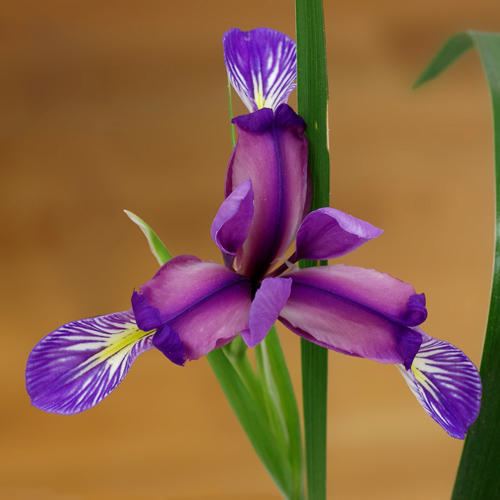
It has slender, short, hard rhizomes. They can have many branches creating dense tufts, clumps or tussocks of plants.
It has narrow grass-like foliage. They can grow up to between 30–100 cm (12–39 in) long and 0.5-1.5 cm wide.
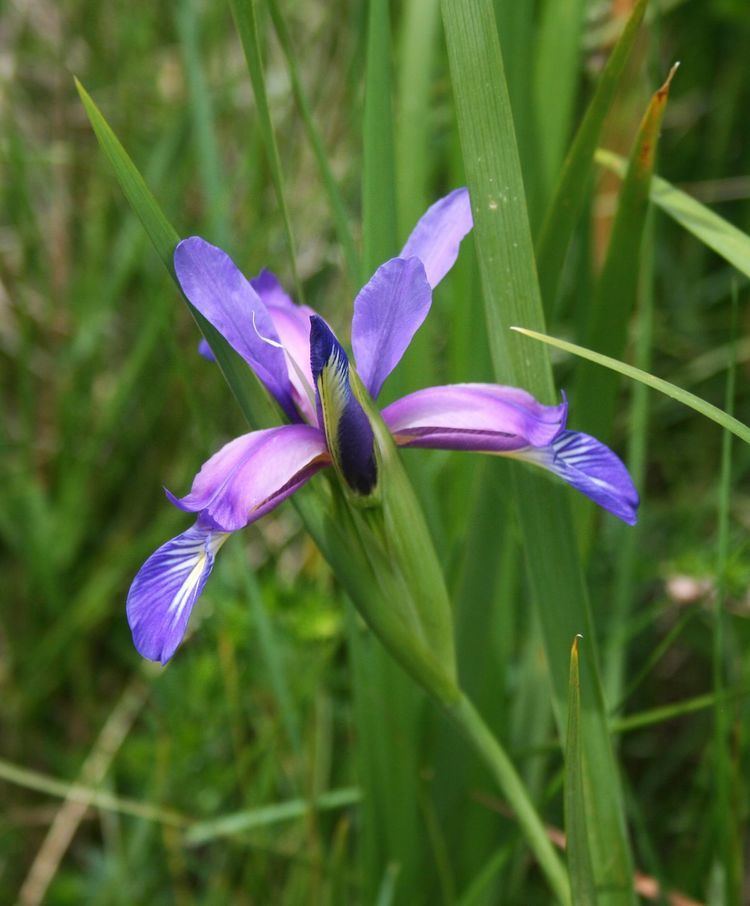
The leaves can be shiny, and bright green above, and pale grey-green (or blue green) below. Some plants can have dark green leaves.
They have strongly, visible longitudinal veins.
The leaves are longer than the flowering stems.
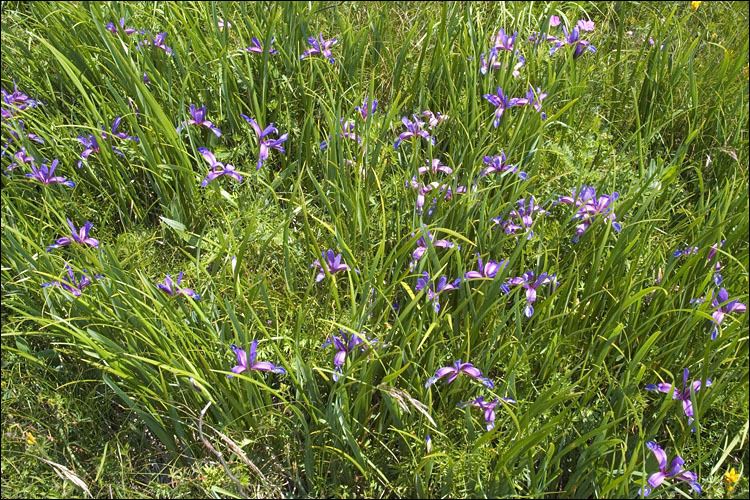
After the plant has flowered, the foliage has the tendency to extend. Later, the deciduous foliage, dies back during the winter.
Iris graminea has a flattened stem, with distinct edges.
That grows up to between 10–60 cm (4–24 in) long.
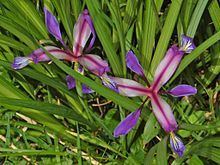
The stems have 1-2 spathes (leaves of the flower bud), which are unequal in size. The lower is larger and rather leaf-like.
The stems hold 1-2 terminal (top of stem) flowers, blooming between spring, and summer, between May and June.

The stems are normally, unbranched, but (if they have a second flower), the pedicel, is up to 6 cm long.
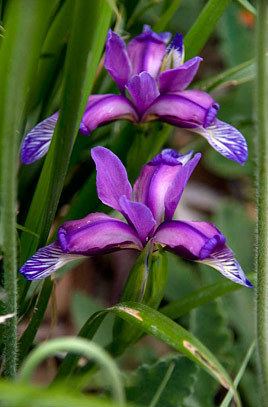
The large flowers are 6–8 cm (2–3 in) in diameter, they are larger than Iris sintenisii flowers. They have a strong scent (or fragrance), which can be variously described as similar to freesias, or fruity, or smell of ripe plums, or apricots, or greengages or between grapes and plum tarts.
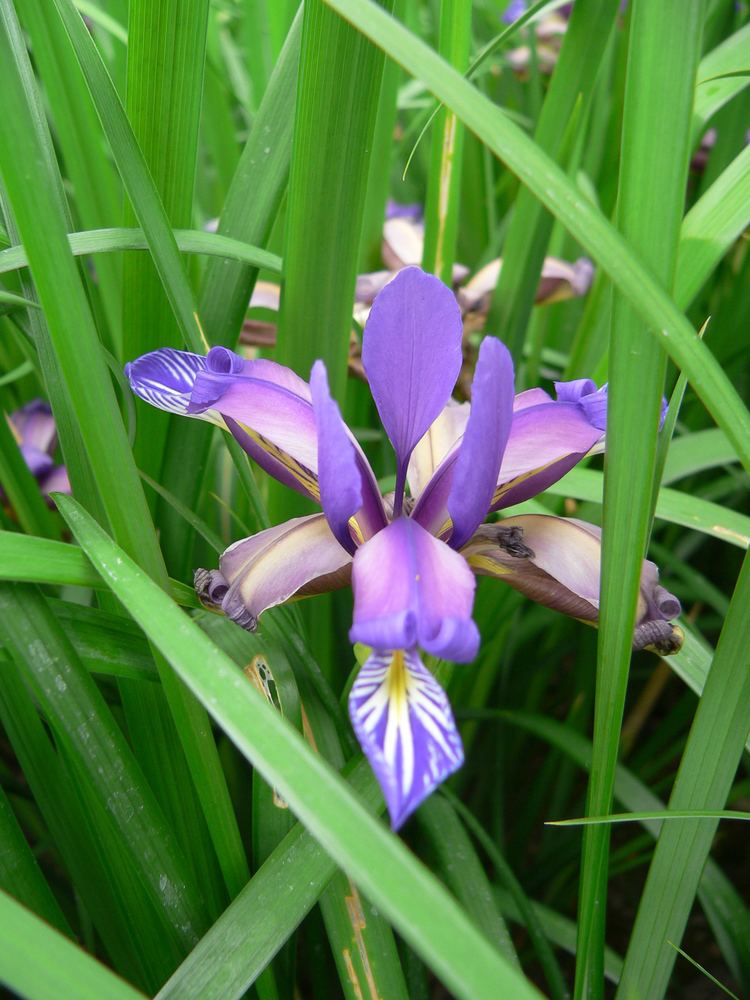
The flowers come in a range of shades, from purple, blue-violet, purple violet violet crimson, reddish purple, violet, lavender, and blue.
It has 2 pairs of petals, 3 large sepals (outer petals), known as the 'falls' and 3 inner, smaller petals (or tepals, known as the 'standards'. The falls have a long haft or claw, (section closest to the stem) and a small rounded or oval blade. They are 3–5 cm (1–2 in) long. The centre of the blade has a pale yellow, or white central area, which is veined with violet, purple, or blue. Some references describe a dark purple area with white veining. The claw is sometimes winged, and tinged with green or brown, or veined deep reddish-purple. The erect, standards are purple blue, or purple, or red-violet, They are 2–5 cm (1–2 in) long, with green or brown shade at the base.
It has a long and arching, purple style branch, (that is long as the haft), and has a dark purple centre stripe. They have a brown base.
It has an ovary with double ridges, a 2 pointed stigma and pollen that is orange-red. It has also has a short perianth tube.
After the iris has flowered, it produces a 3–4 cm (1–2 in) long seed capsule, which has a narrowed point. Inside the capsule, are pear shaped seeds, which are slightly compressed and flattened.
Biochemistry
As most irises are diploid, having two sets of chromosomes. This can be used to identify hybrids and classification of groupings. It has been counted several times including, 2n=34, Simonet 1932; 2n=34, Lenz 1963; 2n=34, Popova, M., & I. Cesmedziev, (1975 & 1976); 2n=34, Colasante & Sauer, 1993; 2n=28, 34, 36, Lovka, 1995 and 2n=34, Dobeš et al., 1997. It is generally published as 2n=34.
Taxonomy
It is pronounced as (Iris) EYE-ris (graminea) gram-IN-ee-a.
It is known as Iris à feuilles de graminées or Iris de Bayonne in France, and Giaggiolo susino in Italy. It is known as kosaciec trawolistny in Polish, and Iris trávolistý in Czechoslovakia. and it is known as zlakovidny iris in Russia, and gräsiris in Swedish,(meaning grass iris).
The Latin specific epithet graminea refers to grassy due to the grass-like leaves.
It has common names of Grass-Leaved Flag (in the US) or Grass leaved Iris, Plum Iris, and Plum tart Iris, or Plum scented Iris, (because of the scent).
It was originally published and described by Carl Linnaeus in Species Plantarum Vol.1 page39 on 1 May 1753.
It was later published by Ker-Gawler in Curtis's Botanical Magazine Vol.18 page681 in 1803. Then by B. Fedtsch in Flora of SSSR Vol.4 page529 in 1935.
It was verified by United States Department of Agriculture Agricultural Research Service on 4 April 2003 and then updated on 1 December 2004.
Iris graminea is an accepted name by the RHS, and it gained the RHS's Award of Garden Merit.
Distribution and habitat
It is native to temperate areas of Europe, and Asia.
Range
It is widespread from Spain to Russia.
Within Asia, it is found in the Caucasus regions, of Georgia, and the Russian Federation, (in Ciscaucasia and Dagestan). Also in Turkey (in Asia Minor).
Within Europe, it is found in Austria, Bulgaria, Czechoslovakia, (in Moravia), Former Yugoslavia, France, Germany, Hungary, Italy, Poland, Romania, Spain, Switzerland, and Ukraine, (in Crimea,).
It may be naturalized in Moravia, and in Germany.
Habitat
It is found growing in scrubland, in grass lands, in meadows (or pastures), in open woods, and in rocky or gravelly soils of the mountains.
Conservation
Iris graminea is an 'endangered species' in Czechoslovakia, it is also listed as 'vulnerable' in Hungary.
In Saxony (Germany), it is listed as rare.
It is thought to be extinct in Poland. It was formerly found near Cieszyn.
It has been listed in various Red Data Books.
Cultivation
Iris graminea is hardy to between USDA Zones 3 to 9. It is hardy to Europe Zone H2. It can survive temperatures as low as -20oC. It is hardy in most places of the UK. During the winter, the foliage dies back, leaving the rhizome under the ground. In very cold climates, a mulch may help the plant survive colder temperatures.
It can be grown in normal garden conditions. They prefer neutral or slightly acidic, (or lime-free), well drained, and fertile (or humus rich) soils. They can tolerate dry soils, or clay and heavy soils, but it prefers damp soils.
They prefer positions in full sun, and can tolerate partial shade.
It requires adequate watering, during growth. such as a moist spring and then drier during the summer. Mature plants can tolerate drought periods.
It can be fertilized in early spring and after flowers have bloomed.
They can be grown in a front of a mixed border, or rockery. As well as being naturalized in the garden, they can be also grown in containers, as long as they are well watered. The flowers can be used in bouquets, so can also be grown in a cutting garden.
They do not like root disturbance, similar to other spuria irises.
It suffers from no serious insect or disease problems. Crown rot is an infrequently occurring disease problem. It is susceptible to certain viruses, such as bacterial leaf blight, soft rot, rhizome rot, leaf spot, rust, viruses and scorch. It is also can be susceptible to damage by Iris borer, verbina bud moth, white flies, iris weevil, thrips, slugs, snails, aphids and nematodes. It can also tolerate damage from deer. Aphid Aphis newtoni can be found on the plant.
The iris has been cultivated since at least 1568.
It was first grown in Cambridge Botanic Garden in 1733, it was labelled as narrow leafed plum scent iris.
For many years it was grown in St. Petersburg Botanical Garden, and the botanical garden of Ufa.
It is the most commonly grown, Iris spuria species, and can be more easily found in plants nurseries. Although it is most commonly known in Europe.
Propagation
It can also be propagated by division or by seed growing.
It rarely needs lifting and dividing. Large clumps of mature plants can be lifted between mid-summer to early autumn, then divided before being replanted. As it does not like root disturbance, so seed growing is preferred. If re-planted, they can take a year to 'settle' before beginning to bloom again.
Seeds are collected from the pods after flowering. Seeds are then sown in containers in a cold frame in autumn, or between September to May.
Seeds should be kept moist for about 2–4 weeks and also warm (at about 15-20 °C). Then temperatures between -4 °C and + 4 °C suspend for 4–6 weeks. These conditions are best reached at the autumn sowing outdoors. Seed trays should then be kept at temperatures of 5 °C to + 10 °C after the cooling period, for a few weeks. In the wild, these freezing and heat period) conditions take place naturally.
The plants need to grow and mature for about 2–3 years before they begin to flower.
Hybrids and Cultivars
Iris graminea has the following known varieties such as; 'Achtaroffii', 'Adami', 'Colchica', 'Graminea Lamprophylla', 'Graminea Sylvatica', 'Graminea latifolia', 'Gravenia', 'Hort's variety', 'Pseudocyperus'.
I. graminea var. pseudocyperus ranges from Czech Republic, Romania, Transylvania, and Slovakia. var. pseudocyperus has broad leaves, but no scent.
